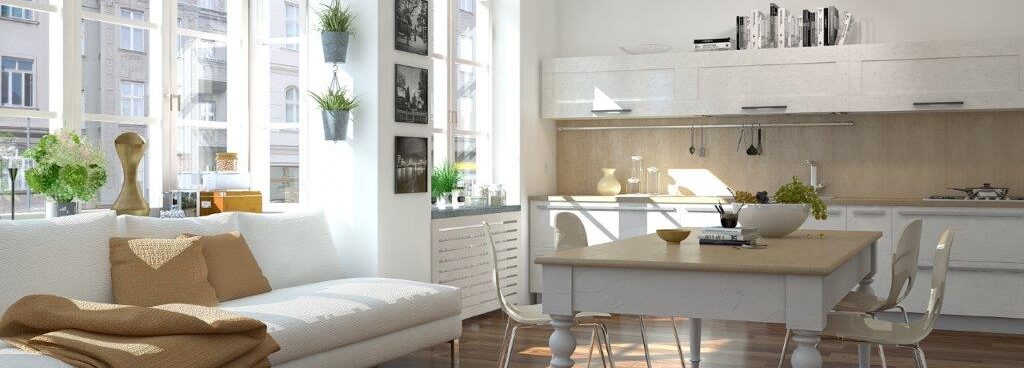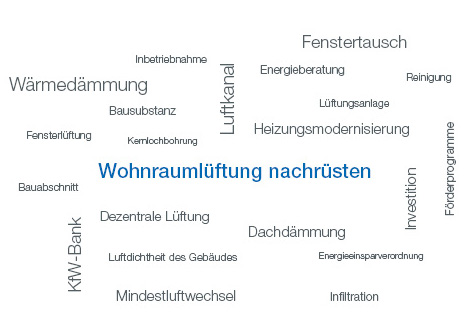Retrofitting living space ventilation - a system comparison in the practice check
There are many reasons for retrofitting living space ventilation: Your own four walls are constantly supplied with fresh air, built-in filters keep pollen, dust and other dirt particles out, and noise stays outside thanks to soundproofing accessories. A ventilation system guarantees a continuous exchange of air, which prevents moisture in rooms and thus the formation of mold and ensures a pleasant living environment. In addition, a ventilation system with heat recovery sustainably lowers heating costs.
Retrofitting controlled living space ventilation is a worthwhile investment and is sometimes required by law. According to DIN 1946-6, a ventilation concept is required for renovations if more than a third of the windows are replaced or more than a third of the roof area is sealed. If the natural airflow in the house is no longer sufficient after these measures, homeowners must retrofit a ventilation system. An expert will check whether this is the case.
You can choose between two different ventilation systems – centralized and decentralized. In the following guide we will highlight which system can best be retrofitted. We also give you assembly tips and explain how you can benefit from attractive KfW subsidies.

Retrofitting living space ventilation - complex piping system vs. core hole drilling
Retrofitting a central ventilation system is associated with greater structural and financial effort. Since a complex pipeline system has to be laid and clad in the house, thus interfering with the building fabric, the house is not habitable for several days. Of course, several trades are necessary for such large construction projects. The ventilation unit also requires a permanent installation location with an appropriate power connection and condensate drainage. Last but not least, the built-in air ducts must be cleaned regularly by a specialist company for reasons of hygiene. This involves a (financial) expense that is often avoided in practice.
Retrofitting decentralized living space ventilation is much easier. All you have to do is drill a core hole, where furniture and home textiles only need to be covered. The effort required to drill the core hole depends on the nature, material and thickness of the wall. This takes a maximum of 3.5 hours per ventilation device. The hardening takes 24 hours. Then the devices are wired and put into operation.
Tip: You should plan around 2 days from preparation to commissioning. Decentralized ventilation systems are integrated into the outer walls in pairs. Usually this means one to two devices per room. This means that you do not have to carry out the installation in one go, but can proceed step-by-step if, for example, renovation is planned for a residential section anyway. The installation location can also be selected flexibly. There is no central device that requires a permanent installation location. In principle, you do not necessarily have to hand over the installation to specialist specialists. With technical understanding and skill, you can do it yourself. The specialist only has to make the electrical connection.
Conclusion: Central ventilation systems are quite expensive both to purchase and to install and are more suitable for a new building. Decentralized ventilation systems are usually cheaper to purchase and can be installed quickly and easily in existing buildings.
Attention: The window rebate ventilation is only suitable for retrofitting to a limited extent. On the one hand, the “free ventilation” through the ventilation slots in the window frame causes heat losses. On the other hand, an air flow must be guaranteed between building fronts that are parallel to one another, so that sufficient moisture protection is ensured. This is often not the case, so that protection against moisture damage and mold can hardly be guaranteed. Last but not least, the Kreditanstalt für Wiederaufbau (KfW) does not grant any funding to this less energy-efficient solution.
For a detailed comparison of the systems (including window rebate ventilation), read our advice on ventilation systems in comparison or ventilation systems in the house.
Installation & planning
Decentralized
Central
1. Installation & assembly
How easily can the ventilation be installed?
- flexible system
- installation in sections
- Cabling and core hole drilling necessary
- all in one step
- complex pipe system
- The installation site must be available
2. Ventilation planning
What do I have to consider when planning my ventilation?
- flexible installation location
- Air flows (AF) can be calculated
- restricted installation location
- Planning of complex pipe systems
- AF predictable
3. Required expertise
What technical support do I need?
- Electrical connection required
- Wiring of the devices
- several trades necessary
- Commissioning necessary
4. Acquisition costs
What does the ventilation cost me?
- medium acquisition cost
- High acquisition costs
Retrofitting a decentralized ventilation system in eight steps
Only the following eight steps are necessary to install your decentralized ventilation system:
Carry out core hole drilling
Insert wall sleeve
Fix the wall sleeve
Attach sealing tapes
Screw the weather protection cover to the facade
Insert the ceramic heat accumulator and connect the reversing fan
Attach the inner cover
Establish electrical connection and install controller
You will find a complete overview of the installation including installation and operating instructions as well as an installation video in our installation aid.
Retrofit living space ventilation and benefit from subsidies

Are you planning to retrofit a decentralized ventilation system? Then benefit from funding from the Reconstruction Loan Corporation (KfW). For example, individual measures such as the renewal or installation of a ventilation system are supported with low-cost loans and subsidies as part of the “Program 151/152 Energy Efficient Renovation – Credit”. You can thus receive up to 15 percent of the eligible costs or a maximum of 7,500 euros without having to repay them later.
Our energy experts will support you with the registration. In the first step, we carry out an energy consultation on your property. An expert then creates a renovation concept and covers the construction supervision. Our experts, in turn, ensure that you take advantage of all funding opportunities. You can then apply for a loan or grant from KfW. If you receive a confirmation, the construction project can begin.
You can also read which renovation measures you should consider in our guide energetic renovation – measures and funding opportunities.
Conclusion: When retrofitting, rely on a ventilation system with a future!
Decentralized devices are particularly impressive because of their simple installation, which is why they are suitable for both new buildings and for retrofitting in an existing building. Another practical plus point is the quick and easy cleaning of a decentralized ventilation system. You can do it yourself in five minutes. You don’t need to hire a maintenance company. You can also read our guide to cleaning a decentralized ventilation system.
What else speaks for a decentralized ventilation system? The innovative strength that defines this industry. The ventilation market is growing rapidly and is producing more and more powerful (iV-Smart +) and at the same time quieter (iV14-Zero) and more energy-saving ventilation devices and matching accessories. Rely on future technology if you want to retrofit a ventilation system. Many end users are already leading the way: the demand for decentralized living space ventilation systems has risen sharply over the past few years. Although the industry has only existed since the turn of the millennium, it has overtaken the central systems industry in terms of volume.
They are interested? We plan your renovation free of charge.


